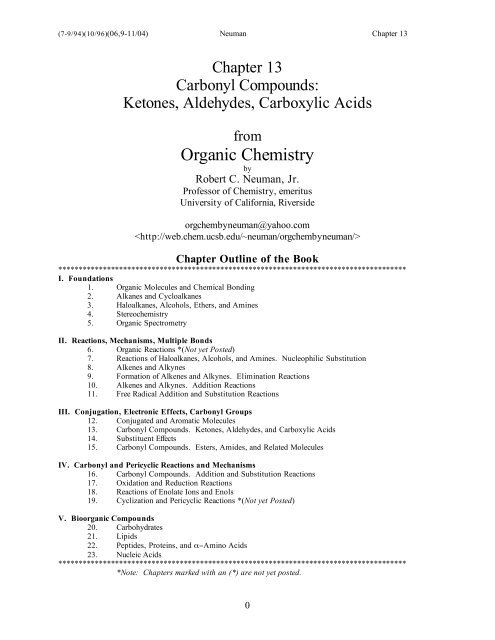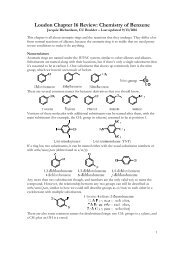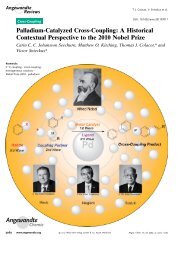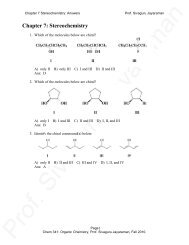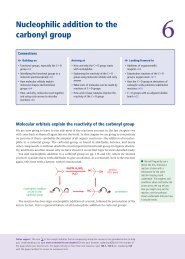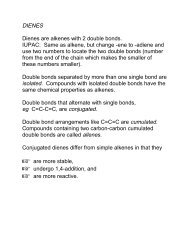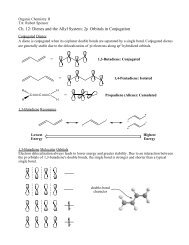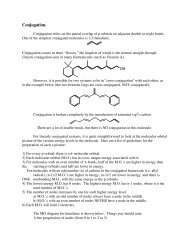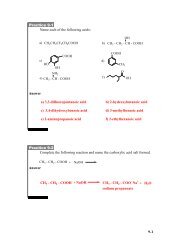chapter 13
chapter 13
chapter 13
Create successful ePaper yourself
Turn your PDF publications into a flip-book with our unique Google optimized e-Paper software.
(7-9/94)(10/96)(06,9-11/04) Neuman Chapter <strong>13</strong><br />
Chapter <strong>13</strong><br />
Carbonyl Compounds:<br />
Ketones, Aldehydes, Carboxylic Acids<br />
from<br />
Organic Chemistry<br />
by<br />
Robert C. Neuman, Jr.<br />
Professor of Chemistry, emeritus<br />
University of California, Riverside<br />
orgchembyneuman@yahoo.com<br />
<br />
Chapter Outline of the Book<br />
**************************************************************************************<br />
I. Foundations<br />
1. Organic Molecules and Chemical Bonding<br />
2. Alkanes and Cycloalkanes<br />
3. Haloalkanes, Alcohols, Ethers, and Amines<br />
4. Stereochemistry<br />
5. Organic Spectrometry<br />
II. Reactions, Mechanisms, Multiple Bonds<br />
6. Organic Reactions *(Not yet Posted)<br />
7. Reactions of Haloalkanes, Alcohols, and Amines. Nucleophilic Substitution<br />
8. Alkenes and Alkynes<br />
9. Formation of Alkenes and Alkynes. Elimination Reactions<br />
10. Alkenes and Alkynes. Addition Reactions<br />
11. Free Radical Addition and Substitution Reactions<br />
III. Conjugation, Electronic Effects, Carbonyl Groups<br />
12. Conjugated and Aromatic Molecules<br />
<strong>13</strong>. Carbonyl Compounds. Ketones, Aldehydes, and Carboxylic Acids<br />
14. Substituent Effects<br />
15. Carbonyl Compounds. Esters, Amides, and Related Molecules<br />
IV. Carbonyl and Pericyclic Reactions and Mechanisms<br />
16. Carbonyl Compounds. Addition and Substitution Reactions<br />
17. Oxidation and Reduction Reactions<br />
18. Reactions of Enolate Ions and Enols<br />
19. Cyclization and Pericyclic Reactions *(Not yet Posted)<br />
V. Bioorganic Compounds<br />
20. Carbohydrates<br />
21. Lipids<br />
22. Peptides, Proteins, and α−Amino Acids<br />
23. Nucleic Acids<br />
**************************************************************************************<br />
*Note: Chapters marked with an (*) are not yet posted.<br />
0
(7-9/94)(10/96)(06,9-11/04) Neuman Chapter <strong>13</strong><br />
<strong>13</strong>: Carbonyl Compounds: Ketones, Aldehydes,<br />
Carboxylic Acids<br />
<strong>13</strong>.1 Carbonyl Compounds <strong>13</strong>-3<br />
The Carbonyl Group (C=O) (<strong>13</strong>.1A) <strong>13</strong>-3<br />
Carbonyl Compounds from Alcohol Oxidation (<strong>13</strong>.1B) <strong>13</strong>-4<br />
<strong>13</strong>.2 Nomenclature <strong>13</strong>-4<br />
Ketones (Alkanones) (<strong>13</strong>.2A) <strong>13</strong>-4<br />
Aldehydes (Alkanals) (<strong>13</strong>.2B) <strong>13</strong>-5<br />
Carboxylic Acids (Alkanoic Acids) (<strong>13</strong>.2C) <strong>13</strong>-7<br />
Carboxylate Ions<br />
Common Nomenclature (<strong>13</strong>.2D) <strong>13</strong>-8<br />
Carboxylic Acids<br />
Aldehydes<br />
Ketones<br />
Acyl Groups<br />
<strong>13</strong>.3 Oxidation and Reduction <strong>13</strong>-12<br />
General Features (<strong>13</strong>.3A) <strong>13</strong>-<strong>13</strong><br />
Oxidation States of Organic Compounds (<strong>13</strong>.3B) <strong>13</strong>-<strong>13</strong><br />
Bond Order of Carbon Atoms<br />
Oxidation Numbers<br />
Aldehydes from Oxidation of 1° Alcohols (<strong>13</strong>.3C) <strong>13</strong>-16<br />
Pyridinium Chlorochromate (PCC)<br />
Other Cr(VI) Reagents<br />
Ketones from Oxidation of Secondary Alcohols (<strong>13</strong>.3D) <strong>13</strong>-16<br />
Oxidation of Tertiary Alcohols is Not a Useful Reaction<br />
Carboxylic Acids from Oxidation of Aldehydes (<strong>13</strong>.3E) <strong>13</strong>-18<br />
Oxidation of Ketones is Not a Useful Reaction<br />
Comparative Oxidation States (<strong>13</strong>.3F) <strong>13</strong>-20<br />
<strong>13</strong>.4 Structure and Reactivity of Groups with C=O <strong>13</strong>-20<br />
Bonding and Structure of Ketones and Aldehydes (<strong>13</strong>.4A) <strong>13</strong>-20<br />
Bonding<br />
Polarity<br />
Bonding and Structure of Carboxylic Acids (<strong>13</strong>.4B) <strong>13</strong>-21<br />
Bonding and Polarity<br />
Hydrogen Bonding<br />
Reactivity and Selectivity of C=O Groups (<strong>13</strong>.4C) <strong>13</strong>-22<br />
Addition of Electrophiles<br />
Addition of Nucleophiles<br />
Conjugate Addition of Nucleophiles<br />
(continued)<br />
1
(7-9/94)(10/96)(06,9-11/04) Neuman Chapter <strong>13</strong><br />
<strong>13</strong>.5 C=O Influence on Reactivity of Neighboring Atoms <strong>13</strong>-24<br />
Acidity of Carboxylic Acids (Y is O) (<strong>13</strong>.5A) <strong>13</strong>-24<br />
Acidity Constants<br />
Resonance Effects<br />
Acidity of Hydrogens on α-Carbons (Y is CR2) (<strong>13</strong>.5B) <strong>13</strong>-26<br />
C-H Ka Values<br />
Enolate Ions and Enols<br />
Keto-Enol Tautomerization<br />
<strong>13</strong>.6 Spectrometric Properties of Carbonyl Compounds <strong>13</strong>-29<br />
Ultraviolet-Visible Spectrometry (<strong>13</strong>.6A) <strong>13</strong>-29<br />
π→π* Excitation<br />
n→π* Excitation<br />
Infrared Spectrometry (<strong>13</strong>.6B) <strong>13</strong>-30<br />
C=O Stretch<br />
C-H Stretch in Aldehydes<br />
O-H Stretch in Carboxylic Acids<br />
C=O Bands in Carboxylic Acids<br />
NMR Spectrometry (<strong>13</strong>.6C) <strong>13</strong>-33<br />
<strong>13</strong> C NMR<br />
1 H NMR<br />
2
(7-9/94)(10/96)(06,9-11/04) Neuman Chapter <strong>13</strong><br />
<strong>13</strong>: Carbonyl Compounds: Ketones, Aldehydes,<br />
Carboxylic Acids<br />
•Carbonyl Compounds<br />
•Nomenclature<br />
•Oxidation and Reduction<br />
•Structure and Reactivity of Groups with C=O<br />
•C=O Influence on Reactivity of Neighboring Atoms<br />
•Spectrometric Properties of Carbonyl Compounds<br />
<strong>13</strong>.1 Carbonyl Compounds<br />
This <strong>chapter</strong> introduces aldehydes, ketones, and carboxylic acids. They are three classes<br />
of carbonyl compounds so named because they all contain the C=O group or carbonyl<br />
group (Figure <strong>13</strong>.1).<br />
Figure <strong>13</strong>.1<br />
There are additional classes of carbonyl compounds that we will introduce in later <strong>chapter</strong>s.<br />
These three classes are grouped together here because we can prepare them by alcohol<br />
oxidation. For this reason, we also preview concepts of organic oxidation and reduction in<br />
this <strong>chapter</strong>, although we revisit it as a unified topic in Chapter 16. At the end of this<br />
<strong>chapter</strong> we describe the unique UV-Visible, IR, and NMR spectrometric features of<br />
compounds containing this group.<br />
The Carbonyl Group (C=O) (<strong>13</strong>.1A)<br />
The C=O group is polar because C and O have different electronegativities.<br />
Figure <strong>13</strong>.2<br />
3
(7-9/94)(10/96)(06,9-11/04) Neuman Chapter <strong>13</strong><br />
We will see that this polar character allows the C=O group to react with both positively<br />
charged and negatively charged reactants. The polar C=O group also activates neighboring<br />
atoms for other types of chemical reactions. Of particular importance is its role in causing<br />
OH protons of carboxylic acids, as well as the α-C-H protons of aldehydes, ketones, and<br />
other carbonyl compounds, to be acidic.<br />
Figure <strong>13</strong>.3<br />
Carbonyl Compounds from Alcohol Oxidation (<strong>13</strong>.1B)<br />
We can form ketones, aldehydes, and carboxylic acids by oxidation of alcohols (Figure <strong>13</strong>.4).<br />
Figure <strong>13</strong>.4<br />
Oxidation of 2° alcohols gives ketones, while oxidation of 1° alcohols gives aldehydes.<br />
Further oxidation of aldehydes gives carboxylic acids. We describe these oxidation reactions<br />
after we introduce the nomenclature of ketones, aldehydes, and carboxylic acids.<br />
<strong>13</strong>.2 Nomenclature<br />
We first describe the systematic nomenclature of ketones, aldehydes, and carboxylic acids and<br />
then present some important common names for these compounds.<br />
Ketones (Alkanones) (<strong>13</strong>.2A)<br />
The two R groups (R 1 and R 2 ) in the general structure of a ketone (Figure <strong>13</strong>.5) must contain<br />
a C atom directly connected to the carbonyl group (neither R can be H).<br />
Figure <strong>13</strong>.5<br />
However the R groups do not have to be identical as we see in specific examples of simple<br />
ketones we show in Figure <strong>13</strong>.6 [next page] along with their systematic names.<br />
4
(7-9/94)(10/96)(06,9-11/04) Neuman Chapter <strong>13</strong><br />
Figure <strong>13</strong>.6<br />
The longest continuous carbon chain containing the C=O group provides the root name of the<br />
compound. Systematic names for ketones are analogous to those for structurally similar 2°<br />
alcohols because ketones are formed by oxidation of the corresponding 2° alcohol. We show<br />
some pairs of.ketones and their 2° alcohol precursors in Figure <strong>13</strong>.7<br />
Figure <strong>13</strong>.7<br />
You can see that the ending "ol" in the name of the precursor alcohol is simply replaced with<br />
the ending "one" in the product ketone. We designate the position of the C of the C=O<br />
group in the chain using a number in front of the root "alkanone" name just as we designate<br />
the position of the C of C-OH in the precursor 2° alcohol.<br />
Aldehydes (Alkanals) (<strong>13</strong>.2B)<br />
The general structure of an aldehyde looks like that of a ketone. However, aldehydes must<br />
have at least one H bonded to the C=O (Figure <strong>13</strong>.8).<br />
Figure <strong>13</strong>.8<br />
As a result, the C=O group of aldehydes is always at the end of an alkane chain. In contrast,<br />
the C=O group of a ketone can never be at the end of an alkane chain and must always be part<br />
of the interior of that chain.<br />
5
(7-9/94)(10/96)(06,9-11/04) Neuman Chapter <strong>13</strong><br />
We systematically name aldehydes as "alkanals" and show simple examples in Figure <strong>13</strong>.9.<br />
Figure <strong>13</strong>.9<br />
The systematic nomenclature for aldehydes derives from the systematic nomenclature for 1°<br />
alcohols because oxidation of 1° alcohols gives aldehydes.<br />
The ending "ol" in the name of the precursor 1° alcohol is replaced by the ending "al" in the<br />
aldehyde product. Since the C of the C=O group is always at the end of the chain, we do not<br />
need to use a number to designate the position of the C=O group. We show some examples<br />
of pairs of aldehydes and their precursor 1° alcohols in Figure <strong>13</strong>.10.<br />
Figure <strong>13</strong>.10<br />
However remember that we must include the number "1" in the 1° alcohol name because we<br />
name all alcohols as "alkanols" whether the OH group is at C1 or C2 or on any other carbon<br />
of the chain.<br />
When the R group of an aldehyde is a cycloalkyl group, we name these compounds in the<br />
manner shown in Figure <strong>13</strong>.11.<br />
Figure <strong>13</strong>.11<br />
6
(7-9/94)(10/96)(06,9-11/04) Neuman Chapter <strong>13</strong><br />
We can also replace the ending carboxaldehyde with the ending carbaldehyde as we show in<br />
that figure.<br />
Aldehydes versus Ketones. Why are aldehydes and ketones placed in separate classes while 1° and<br />
2° alcohols are not? This is probably the result of early chemists' observations that aldehydes undergo<br />
some important chemical reactions not available to ketones. For example we have already mentioned<br />
that aldehydes are oxidized to carboxylic acids of the same chain length. However, oxidation of<br />
ketones is very difficult, and when it occurs an R group is generally lost and the length of the chain<br />
containing the C=O group decreases (Figure <strong>13</strong>.12).<br />
Figure <strong>13</strong>.12<br />
The chain length remains the same during oxidation of aldehydes because the C=O group is at the very<br />
end of the chain.<br />
However, since most other chemical reactions of aldehydes and ketones are similar, it is likely that<br />
if they had been discovered recently they would not have been separated into two separate classes.<br />
Proposals have been made to use the ketone nomenclature system for both aldehydes and ketones<br />
(aldehydes would be named as 1-alkanones) however these proposals have not yet prevailed.<br />
Carboxylic Acids (Alkanoic Acids) (<strong>13</strong>.2C)<br />
We can always call the C=O group a carbonyl group, but when it is attached to an OH, the<br />
resulting C(=O)OH structure is a new functional group called the carboxy group or<br />
carboxylic acid group found in carboxylic acids whose general structure we show again in<br />
Figure <strong>13</strong>.<strong>13</strong> where the R group can be H or contain a C directly bonded to C=O.<br />
Figure <strong>13</strong>.<strong>13</strong><br />
You can see that carboxylic acids look like aldehydes in which an O has been inserted<br />
between the H attached to the C=O to give an OH group. This comparison is useful since<br />
7
(7-9/94)(10/96)(06,9-11/04) Neuman Chapter <strong>13</strong><br />
carboxylic acids arise from oxidation of aldehydes as we described earlier. We show some<br />
carboxylic acids and their names in Figure <strong>13</strong>.14.<br />
Figure <strong>13</strong>.14<br />
Their systematic names are usually derived from the name of the precursor aldehyde by<br />
replacing the ending "al" in the aldehyde name with the ending "oic acid" for the carboxylic<br />
acid. "Cycloalkane carboxylic acids" are an exception as we also illustrate in Figure <strong>13</strong>.14.<br />
Carboxylate Ions. When carboxylic acids react with bases, as we describe later in this<br />
<strong>chapter</strong>, they form carboxylate ions.<br />
Base<br />
R-C(=O)OH → R-C(=O)O -<br />
Carboxylic acid<br />
Carboxylate ion<br />
We systematically name carboxylate ions by dropping the ending "-ic acid" from the names of<br />
their precursor carboxylic acids and replacing it with the ending "-ate" as we show in Figure<br />
<strong>13</strong>.15 using as examples the carboxylic acids from Figure <strong>13</strong>.14.<br />
Figure <strong>13</strong>.15<br />
Common Nomenclature (<strong>13</strong>.2D)<br />
A number of simple ketones, aldehydes, and carboxylic acids have common names that are<br />
used more frequently than their systematic names.<br />
Carboxylic Acids. We show several simple carboxylic acids and their common names in<br />
Figure <strong>13</strong>.16 [next page] along with their systematic names in parentheses. The common<br />
names marked with an asterix (*) are almost always used instead of the corresponding<br />
systematic names.<br />
8
(7-9/94)(10/96)(06,9-11/04) Neuman Chapter <strong>13</strong><br />
Figure <strong>13</strong>.16<br />
This is also true for the simple dicarboxylic acids (Figure <strong>13</strong>.17) that we name using their<br />
common names, rather than systematic names, shown in parentheses below the common<br />
names.<br />
Figure <strong>13</strong>.17<br />
When we use common names for simple acids with substituents, we use Greek letters rather<br />
than numbers to indicate locations of those substituents as in the examples in Figure <strong>13</strong>.18.<br />
Figure <strong>13</strong>.18<br />
These Greek letters reflect the position of the carbon atom bearing the substituent with<br />
respect to the C=O group as we show in the general structure in Figure <strong>13</strong>.19.<br />
Figure <strong>13</strong>.19<br />
We do not use Greek letters in systematic names, but can use them in conversation to indicate<br />
the relationship of a substituent to the C=O group. Using the acid in Figure <strong>13</strong>.20 [next page]<br />
9
(7-9/94)(10/96)(06,9-11/04) Neuman Chapter <strong>13</strong><br />
as our example, we can say that the fluorine atom is "beta" (β) to the carboxylic acid group<br />
whether we name the acid with common or systematic nomenclature.<br />
Figure <strong>13</strong>.20<br />
Common names of carboxylate ions are usually derived from the common names of carboxylic<br />
acids by dropping the ending "ic acid" and replacing it with "ate" as in Figure <strong>13</strong>.21.<br />
Figure <strong>13</strong>.21<br />
Aldehydes. Simple aldehydes have common names that are directly related to those of the<br />
carboxylic acids (Figure <strong>13</strong>.22) that they form on oxidation. Their systematic names are<br />
included in parentheses in this figure.<br />
Figure <strong>13</strong>.22<br />
We use Greek letters to designate positions of substituents on aldehydes in the same ways as<br />
we did for carboxylic acids. The asterix (*) shows aldehydes whose common names are<br />
virtually always used in place of their systematic names.<br />
10
(7-9/94)(10/96)(06,9-11/04) Neuman Chapter <strong>13</strong><br />
Ketones. Ketones do not have common names like those we have just described for<br />
aldehydes and carboxylic acids. However simple ketones have other types of common names<br />
that are frequently used in place of their systematic names.<br />
One type is similar to that described for ethers in Chapter 3. The two R groups attached to<br />
the C=O group are each named as an alkyl group and those alkyl group names are placed in<br />
front of the word "ketone" as we show in Figure <strong>13</strong>.23.<br />
Figure <strong>13</strong>.23<br />
This method is particularly useful for naming simple ketones with cycloalkyl groups directly<br />
attached to the C=O group.<br />
A second type is used specifically for ketones with the general structure<br />
Ar-C(=O)-R where Ar represents a benzene or arene ring attached to the carbonyl group as<br />
we show in Figure <strong>13</strong>.24 Systematic names are again shown in parentheses.<br />
Figure <strong>13</strong>.24<br />
In these examples, the arene portion of the molecule is designated by the endings phenone or<br />
naphthone as appropriate. The other group attached to C=O (R-C=O) is indicated in the<br />
name by a prefix derived from the common name of the corresponding carboxylic acid R-<br />
C(=O)-OH.<br />
11
(7-9/94)(10/96)(06,9-11/04) Neuman Chapter <strong>13</strong><br />
For example, the prefix aceto in acetophenone (see figure above) is derived from the prefix<br />
acet in acetic acid. Similarly that prefix acet is used in the common name acetone, that<br />
belongs to the very familiar ketone in Figure <strong>13</strong>.25.<br />
Figure <strong>13</strong>.25<br />
Acyl Groups. Organic chemists often find it useful to refer to the whole R-C(=O) group<br />
by a single name. One example is when such a group is attached to an aromatic ring as we<br />
show in Figure <strong>13</strong>.26.<br />
Figure <strong>13</strong>.26<br />
For example we can refer to the R-C(=O) group on anthracene in Figure <strong>13</strong>.26 as an acyl<br />
group or alkanoyl group. We show specific names of various acyl groups with different R's<br />
in Figure <strong>13</strong>.27.<br />
Figure <strong>13</strong>.27<br />
<strong>13</strong>.3 Oxidation and Reduction<br />
Because oxidation reactions are important synthetic routes to ketones, aldehydes, and<br />
carboxylic acids we describe these reactions and the reverse reduction reactions in more detail<br />
in this section.<br />
12
(7-9/94)(10/96)(06,9-11/04) Neuman Chapter <strong>13</strong><br />
General Features (<strong>13</strong>.3A)<br />
We summarize the oxidation pathways that convert alcohols to ketones or aldehydes, and<br />
aldehydes to carboxylic acids, in Figure <strong>13</strong>.28.<br />
Figure <strong>13</strong>.28<br />
Each of these transformations can also occur in the reverse direction, and these reverse<br />
reactions are called reduction reactions. The symbols [O] and [H] above or below the<br />
reaction arrows are used to signify that the reaction is an oxidation reaction [O], or a<br />
reduction reaction [H].<br />
Oxidation States of Organic Compounds (<strong>13</strong>.3B)<br />
We use the oxidation of methanol to methanal, and its reverse reduction reaction (Figure<br />
<strong>13</strong>.29), to illustrate how we can determine their relative oxidation states using oxidation<br />
numbers of C atoms or the bond order of the carbon-oxygen bond.<br />
Figure <strong>13</strong>.29<br />
Bond Order of Carbon Atoms. In general, the oxidation level of a C increases (the C is<br />
more oxidized) as it progresses from being singly, to doubly, to triply bonded to its attached<br />
atoms. For example the C with the attached oxygen in methanol is singly bonded to O and it<br />
is in a lower oxidation state (less oxidized) than the C doubly bonded to O in methanal<br />
(Figure <strong>13</strong>.29). As a result, the conversion of methanol to methanal is oxidation,while the<br />
reverse transformation of methanal to methanol is reduction.<br />
We can visualize the reduction of methanal to methanol by addition of H 2 across the C=O<br />
bond Figure (<strong>13</strong>.30) [next page].<br />
<strong>13</strong>
(7-9/94)(10/96)(06,9-11/04) Neuman Chapter <strong>13</strong><br />
Figure <strong>13</strong>.30<br />
Whether or not this H 2 addition eaction actually occurs, it provides a general method for<br />
determining the relative oxidation states of many organic compounds: A functional group<br />
containing a multiple bond is in a higher oxidation state (more oxidized) than the functional<br />
group that results from adding H 2 across that multiple bond.<br />
A Different Example. Another example of this "rule" is hydrogenation of alkynes and alkenes<br />
(Figure <strong>13</strong>.31) described in Chapter 10.<br />
Figure <strong>13</strong>.31<br />
The triply bonded C's of an alkyne are in higher oxidation states than doubly bonded C's of alkenes<br />
that result from "addition of H2". Similary, the doubly bonded C's of alkenes are in higher oxidation<br />
states than the singly bonded C's of alkanes resulting from H2 "addition".<br />
We summarize this "rule" by comparing the relative oxidation states of carbon in different<br />
types of compounds in Figure <strong>13</strong>.32.<br />
Figure <strong>13</strong>.32<br />
[H] and [O]. It is important to understand that the general symbol [H] that we used to generally<br />
represent reduction reactions in Figures <strong>13</strong>.28 and <strong>13</strong>.29 does not specifically mean H2 that we show<br />
in Figures <strong>13</strong>.30-<strong>13</strong>.32. Chemists use the symbol [H] to represent many different types of reduction<br />
reagents. However, [H] was obviously chosen because H2 reduces a variety of multiple bonds.<br />
Similarly, [O] was chosen to designate an oxidation reaction because O2 oxidizes organic compounds.<br />
Oxidation Numbers. Oxidation numbers, as described in General Chemistry courses, can<br />
be used to determine the relative oxidation states of organic compounds. We illustrated this<br />
14
(7-9/94)(10/96)(06,9-11/04) Neuman Chapter <strong>13</strong><br />
in Chapter 10 using hydrogenation of alkenes that is a reduction reaction. Although they are<br />
not routinely used by organic chemists, we use them to compare the oxidation states of<br />
methanol and methanal in Figure <strong>13</strong>.33.<br />
Figure <strong>13</strong>.33<br />
Details of Oxidation Number Calculations. The rules used to calculate these numbers are similar<br />
to those used for inorganic molecules. The H atoms are assigned an oxidation number of +1 when<br />
they are bonded to C or to more electronegative atoms. In contrast, oxygen atoms, whether singly or<br />
doubly bonded, are assigned the oxidation number -2 except when they are bonded to another oxygen.<br />
We designate the unknown oxidation number of C in each molecule as X. Since the sum of the<br />
oxidation numbers of all atoms in a particular compound must equal the net ionic charge on that<br />
compound, and the ionic charge on both methanol and methanal is zero (0), we obtain the algebraic<br />
equations shown below each molecule in Figure <strong>13</strong>.33.<br />
Solution of these equations gives the oxidation number X = -2 for the C in methanol (CH3OH)<br />
and the more positive (greater) oxidation number X = 0 for the C in methanal (H2C=O). Conversion<br />
of methanol to methanal causes the oxidation number for the C bonded to O to become more positive<br />
(an increase from -2 to 0) signifying that the C has been oxidized.<br />
15
(7-9/94)(10/96)(06,9-11/04) Neuman Chapter <strong>13</strong><br />
Aldehydes from Oxidation of 1° Alcohols (<strong>13</strong>.3C)<br />
Any 1° alcohol (RCH 2 OH) can be oxidized to an aldehyde as we show in the general<br />
equation, and some specific examples, in Figure <strong>13</strong>.34.<br />
Figure <strong>13</strong>.34<br />
Pyridinium Chlorochromate (PCC). We show a reagent and solvent for this oxidation in<br />
the reaction in Figure <strong>13</strong>.35.<br />
Figure <strong>13</strong>.35<br />
The oxidizing agent pyridinium chlorochromate (PCC) (Figures <strong>13</strong>.35 and <strong>13</strong>.36) contains<br />
Cr(VI) that is reduced to a lower oxidation state as it oxidizes the alcohol to the aldehyde.<br />
Figure <strong>13</strong>.36<br />
Other Cr(VI) Reagents. PCC is a specialized oxidizing reagent that is less powerful<br />
than other Cr(VI) reagents such as Na 2 Cr 2 O 7 , K 2 Cr 2 O 7 , or CrO 3 , that are also used to<br />
oxidize alcohols. These more powerful reagents not only oxidize 1° alcohols to<br />
aldehydes, but further oxidize aldehydes to carboxylic acids. As a result, PCC is a reagent<br />
of choice when an aldehyde is the desired product. All of these Cr(VI) reagents and their<br />
chemistry are discussed in more detail in Chapter 17<br />
Ketones from Oxidation of Secondary Alcohols (<strong>13</strong>.3D)<br />
Oxidation of 2° alcohols leads to the formation of ketones (Figure <strong>13</strong>.37).<br />
Figure <strong>13</strong>.37<br />
We can see this in the formula where H's "disappear" from the C and the O converting the<br />
CH-OH group into the C=O group. Since the C in C=O is doubly bonded to the oxygen, that<br />
16
(7-9/94)(10/96)(06,9-11/04) Neuman Chapter <strong>13</strong><br />
C is in a higher oxidation state than the C in the CH-OH group and you can verify this using<br />
oxidation numbers.<br />
Comparative Oxidation Numbers for 2° Alcohols and Ketones. We can simplify calculations of<br />
C oxidation numbers because the R groups do not change as the secondary alcohol is oxidized to the<br />
ketone. We do not need to include R groups in our calculations to show that C in CH-OH has a<br />
lower oxidation number than C in the C=O group (Figure <strong>13</strong>.38).<br />
Figure <strong>13</strong>.38<br />
When we calculate C oxidation numbers by this shorthand approach without considering the R<br />
groups, the absolute values of those C oxidation numbers have no significance. They have meaning<br />
only in their comparison or difference. Similarly, we can ignore the R groups when we compare the<br />
oxidation states of C in primary alcohols with those of their product aldehydes.<br />
We can use PCC in CH 2 Cl 2 to convert 2° alcohols to ketones as we did for oxidation of 1°<br />
alcohols to aldehydes. However, we can also use more powerful oxidizing agents made by<br />
dissolving sodium or potassium dichromate (Na 2 Cr 2 O 7 or K 2 Cr 2 O 7 ) or chromium trioxide<br />
(CrO 3 ) in aqueous solutions of sulfuric or acetic acid (Figure <strong>13</strong>.39) [next page]. In contrast<br />
with aldehydes, ketones are not further oxidized by these more powerful oxidizing agents.<br />
17
(7-9/94)(10/96)(06,9-11/04) Neuman Chapter <strong>13</strong><br />
Figure <strong>13</strong>.39<br />
Oxidation of Tertiary Alcohols is Not a Useful Reaction. We cannot oxidize the C-OH<br />
carbon of a tertiary alcohol to give a C=O group without breaking C-C bonds in the attached<br />
R groups (Figure <strong>13</strong>.40).<br />
Figure <strong>13</strong>.40<br />
As a result, oxidation of tertiary alcohols is NOT a useful synthetic procedure.<br />
Carboxylic Acids from Oxidation of Aldehydes (<strong>13</strong>.3E)<br />
Aldehydes are so easily oxidized to carboxylic acids (Figure <strong>13</strong>.41) that they even slowly<br />
oxidize by exposure to air without added oxidizing reagents.<br />
Figure <strong>13</strong>.41<br />
As a result, we can form carboxylic acids by direct oxidation of 1° alcohols without isolating<br />
the intermediate aldehyde by treating the alcohol with one of the powerful oxidizing agents<br />
that we described in the previous section (Figure <strong>13</strong>.42).<br />
Figure <strong>13</strong>.42<br />
Remember, however, that the weaker oxidizing agent PCC/CH 2 Cl 2 will not oxidize aldehydes<br />
to carboxylic acids.<br />
18
(7-9/94)(10/96)(06,9-11/04) Neuman Chapter <strong>13</strong><br />
Oxidation State of C(=O)OH Groups. Although the number of multiple bonds to C in C(=O)OH<br />
or C(=O)H groups is the same, the C in C(=O)OH is in a higher oxidation state. This is because the<br />
C-H bond in the C(=O)H group has been replaced with a C-O bond. You can verify this by<br />
calculating the oxidation number of C in each of these two groups (Figure <strong>13</strong>.43).<br />
Figure <strong>13</strong>.43<br />
These calculations show that the oxidation number for the carbon is more positive in the CO2H group<br />
than the C in the CHO group and therefore the C in CO2H is in a higher oxidation state. Since the<br />
oxidation number of the R group does not change, we can ignore it as we previously did when we<br />
compared the oxidation states of alcohols with those of aldehydes or ketones.<br />
Oxidation of Ketones is Not a Useful Reaction. Oxidation of a ketone to a carboxylic<br />
acid disrupts the carbon skeleton of the molecule (refer to Figure <strong>13</strong>.12). This is analogous to<br />
the situation that we described above for 3° alcohols and is the reason that oxidations of<br />
tertiary alcohols or ketones are generally not useful reactions.<br />
However, one exception is the oxidation of cyclic ketones and cyclic alcohols by Cr(VI)<br />
oxidizing agents to give dicarboxylic acids as we show in Figure <strong>13</strong>.44 [TBA].<br />
19
(7-9/94)(10/96)(06,9-11/04) Neuman Chapter <strong>13</strong><br />
Comparative Oxidation States (<strong>13</strong>.3F)<br />
We summarize and compare the oxidation states/levels of alcohols, ketones and aldehydes,<br />
and carboxylic acids in the diagram shown here.<br />
Increasing Oxidation State →<br />
Alcohols Aldehydes and Ketones Carboxylic Acids<br />
RCH2-OH RC(H)=O RCO2H<br />
R2CH-OH<br />
R2C=O<br />
R3C-OH<br />
<br />
<br />
Alcohols are at lower oxidation levels than those of aldehydes or ketones. Similarly,<br />
aldehydes and ketones are at lower oxidation levels than that of carboxylic acids. It is<br />
important that you remember these general comparisons since oxidation and reduction<br />
reactions of these functional groups are very important in organic chemistry.<br />
<strong>13</strong>.4 Structure and Reactivity of Groups with C=O<br />
This section describes bonding, geometry, polarity, and reactivity of C=O groups.<br />
Bonding and Structure of Ketones and Aldehydes (<strong>13</strong>.4A)<br />
C=O groups in ketones and aldehydes have the same bonding and polarity.<br />
Bonding. We described molecular orbitals of C=O double bonds in Chapter 1. We assign<br />
sp 2 hybridization to both the C and O so that a C=O group has an sp 2 -sp 2 σ bond, as well as<br />
a 2p-2p π bond between the C and O atoms (Figure <strong>13</strong>.45).<br />
Figure <strong>13</strong>.45<br />
The sp 2 hybridization of C agrees with the observed planarity of the carbonyl groups and the<br />
approximately120° angles between their attached groups. Actual bond angles vary with the<br />
size of the attached groups as we see in the calculated structures that we show in Figure<br />
<strong>13</strong>.46 [next page].<br />
20
(7-9/94)(10/96)(06,9-11/04) Neuman Chapter <strong>13</strong><br />
Figure <strong>13</strong>.46<br />
Polarity. O is significantly more electronegative than C, so C=O double bonds are<br />
polarized with a partially positive C and a partially negative O (Figure <strong>13</strong>.47).<br />
Figure <strong>13</strong>.47<br />
Since the C=O group has a π bond, we can represent this polarity using the resonance<br />
structure with a positive charge on C and a negative charge on O that we have labelled as<br />
"good" (Figure <strong>13</strong>.48).<br />
Figure <strong>13</strong>.48<br />
The "bad" resonance structure with the opposite polarity and the large "X" drawn through<br />
the resonance arrow is not a significant resonance contributor because its atom polarities are<br />
inconsistent with the relative electronegativities of C and O. As a result of this polarity,<br />
C=O has a significant dipole moment (see Figure <strong>13</strong>.47).<br />
Bonding and Structure of Carboxylic Acids (<strong>13</strong>.4B)<br />
There are similarities and differences between C=O groups in carboxylic acids and those in<br />
aldeydes and ketones.<br />
Bonding and Polarity. The C(=O)OH group (CO 2 H group) of carboxylic acids is also<br />
planar and the C is sp 2 hybridized as it is in ketones and aldehydes (Figure <strong>13</strong>.49).<br />
Figure <strong>13</strong>.49<br />
The C=O in CO 2 H is polar as in ketones and aldehydes, but the unshared electron pairs on<br />
OH permit an additional resonance structure to be drawn where one of those pairs is<br />
delocalized into the C=O group (Figure <strong>13</strong>.50) [next page].<br />
21
(7-9/94)(10/96)(06,9-11/04) Neuman Chapter <strong>13</strong><br />
Figure <strong>13</strong>.50<br />
Hydrogen Bonding. In contrast with ketones and aldehydes, the OH group in carboxylic<br />
acids permits hydrogen bonding between RCO 2 H molecules. As a result, H-bonded dimers<br />
composed of two carboxylic acid molecules (Figure <strong>13</strong>.51) are relatively stable.<br />
Figure <strong>13</strong>.51<br />
These dimers are the predominant way that RCO 2 H molecules exist in pure carboxylic acids<br />
or when carboxylic acids are dissolved in nonpolar solvents.<br />
When a carboxylic acid is dissolved in a polar protic solvent such as water, the dimeric<br />
structure is replaced by H-bonding between a carboxylic acid molecule and water molecules<br />
(Figure <strong>13</strong>.52). This H-bonded structure is like that we would expect for solutions of<br />
aldehydes or ketones in water (Figure <strong>13</strong>.53).<br />
Reactivity and Selectivity of C=O Groups (<strong>13</strong>.4C)<br />
The polarity of C=O groups affects the selectivity of its addition reactions. This is a brief<br />
overview of the detailed discussion in Chapter 16.<br />
Addition of Electrophiles. Electrophiles readily add to C=O bonds, just as they do to<br />
C=C bonds. However electrophiles react with C=O bonds exclusively at the O atom. A very<br />
important example of electrophilic addition to a C=O group is protonation (Figure <strong>13</strong>.54).<br />
Figure <strong>13</strong>.54<br />
Protonization of O leads to the formation of a cationic species where the positive charge is<br />
delocalized on both O and C (Figure <strong>13</strong>.54).<br />
22
(7-9/94)(10/96)(06,9-11/04) Neuman Chapter <strong>13</strong><br />
In contrast, C=O polarity (Figure <strong>13</strong>.47) makes addition of a proton to the positively<br />
polarized carbon very unfavorable. Protonation on C would give a cation, with an<br />
unfavorable positively charged O, that cannot be resonance stabilized (Figure <strong>13</strong>.55).<br />
Figure <strong>13</strong>.55<br />
Addition of Nucleophiles. While C=C bonds of alkenes generally do not react with<br />
nucleophiles (N:), nucleophiles readily add to C=O bonds. As a direct result of the polarity<br />
of the C=O group, the nucleophile always adds to the C (Figure <strong>13</strong>.56).<br />
Figure <strong>13</strong>.56<br />
Examples include the addition of nucleophiles like alkoxide ions (RO - ), or amines (eg. RNH 2 )<br />
where addition is exclusively at the carbonyl carbon (Figure <strong>13</strong>.57).<br />
Figure <strong>13</strong>.57<br />
The resultant oxygen anion (Figure <strong>13</strong>.57) is electronically equivalent to the negatively<br />
charged O in alkoxide (RO - ) and hydroxide ions (HO - ).<br />
Conjugate Addition of Nucleophiles. Although nucleophiles such as alkoxide ions or<br />
amines do not add to simple alkenes, they do add to C=C bonds that are conjugated with a<br />
C=O group. These conjugate addition reactions are also a direct result of the polarity of<br />
the C=O group that we have just discussed. The nucleophile adds to the C of the C=C bond<br />
that permits delocalization of the C=C π electrons into the C=O group (Figure <strong>13</strong>.58).<br />
Figure <strong>13</strong>.58<br />
We cover all of these addition reactions in detail in Chapter 16.<br />
23
(7-9/94)(10/96)(06,9-11/04) Neuman Chapter <strong>13</strong><br />
<strong>13</strong>.5 C=O Influence on Reactivity of Neighboring Atoms<br />
The C=O group has a dramatic influence on the chemical properties of its neighboring atoms.<br />
We have just described that it activates conjugated C=C bonds for nucleophilic addition.<br />
However its most important effect is on acidities of H's that are on atoms directly bonded to<br />
the C=O group (Figure <strong>13</strong>.59).<br />
Figure <strong>13</strong>.59<br />
The following sections illustrate this effect when Y is O, or CR 2 .<br />
Acidity of Carboxylic Acids (Y is O) (<strong>13</strong>.5A)<br />
The H's on OH groups of water or alcohols are so weakly acidic that we do not think of HO-<br />
H or RO-H as acids. However when an OH group is bonded to a C=O group (Figure <strong>13</strong>.60),<br />
the OH proton becomes so acidic that we name such compounds as carboxylic "acids".<br />
Figure <strong>13</strong>.60<br />
Acidity Constants. We illustrate this effect of C=O on acidity of OH groups with the<br />
comparative acidity constants of CH 3 CH 2 -OH and CH 3 C(=O)-OH in Figure <strong>13</strong>.61.<br />
Figure <strong>13</strong>.61<br />
The acidity constant K a increases by an enormous factor of 10 11 when we change the CH 2<br />
group (shown in the box) in ethanol (CH 3 CH 2 OH) into the C=O group (shown in the box) to<br />
give acetic acid (CH 3 C(=O)OH).<br />
We see that this increase in K a due to C=O is quite general in the comparison of K a values for<br />
other RCH 2 OH/RC(=O)OH pairs in Table <strong>13</strong>.1 [next page].<br />
24
(7-9/94)(10/96)(06,9-11/04) Neuman Chapter <strong>13</strong><br />
Table <strong>13</strong>.1. Comparative Acidities of Simple Alcohols and Carboxylic Acids<br />
Alcohol K a pK a Carboxylic Acid K a pK a<br />
H(CH 2 )OH 10 -16 16 H(C=O)OH 1.8 x 10 -4 3.8<br />
Me(CH 2 )OH* 10 -16 16 Me(C=O)OH** 1.8 x 10 -5 4.8<br />
Et(CH 2 )OH 10 -16 16 Et(C=O)OH 1.3 x 10 -5 4.9<br />
Pr(CH 2 )OH 10 -16 16 Pr(C=O)OH 1.5 x 10 -5 4.8<br />
Bu(CH 2 )OH 10 -16 16 Bu(C=O)OH 1.5 x 10 -5 4.8<br />
*Ethanol, CH 3 CH 2 OH<br />
**Acetic acid, CH 3 CO 2 H<br />
Acidity, Ka, and pKa. You should review the discussions in Chapter 3 on the use of Ka and<br />
pKa values to measure acidity We will continue to use concepts of acidity and basicity<br />
throughout this text. They will be important in discussions of amino acids, nucleic acids, and<br />
fatty acids, in later <strong>chapter</strong>s of this text and in your biology and biochemistry classes. Ka and<br />
pKa values of these molecules are important physical properties that not only characterize them as<br />
chemical systems, but are crucial to understanding their biological function.<br />
Acidic and basic functional groups are important in biological systems because they can exist<br />
in the same environment with more than one charge type. For example, carboxylic acids can<br />
simultneously exist as neutral or negatively charged forms as we show in Figure <strong>13</strong>.62.<br />
Figure <strong>13</strong>.62<br />
Similarly, amines can simultaneously be neutral or positively charged forms as we show in the<br />
same figure. We will learn that different charge types of such functional groups are of critical<br />
importance in the maintenance of the structure of biological macromolecules.<br />
Resonance Effects. The dramatically greater acidity of each carboxylic acid R(C=O)OH<br />
compared to its corresponding alcohol R(CH 2 )OH is because C=O resonance stabilizes the<br />
negative charge on the carboxylate ion (R(C=O)O - ) that arises by loss of the OH proton of a<br />
carboxylic acid (Figure <strong>13</strong>.63).<br />
Figure <strong>13</strong>.63<br />
Comparable resonance stabilization is not possible for alkoxide ions (R(CH 2 )O - ) that form<br />
from loss of an OH proton from an alcohol.<br />
25
(7-9/94)(10/96)(06,9-11/04) Neuman Chapter <strong>13</strong><br />
Resonance Stabilization of Oxyegen Anions. We used similar resonance stabilization of an oxygen<br />
anion to explain the relatively high acidity of arene OH groups as we described for phenol (PhOH) in<br />
Chapter 12 (Figure <strong>13</strong>.64).<br />
Figure <strong>13</strong>.64<br />
The data in Table <strong>13</strong>.2 show that a C=O group has an effect on O - stability that is even greater than<br />
that of a benzene ring.<br />
Table <strong>13</strong>.2. A Comparison of Acidities of Phenol, Alcohols, and Carboxylic Acids<br />
Compound<br />
Approximate Ka<br />
R-OH 10 -16<br />
Ph-OH 10 -10<br />
R-C(=O)-OH 10 -5<br />
The difference between stabilization by a benzene ring and a C=O is due partly to the fact that the two<br />
resonance structures for a carboxylate anion ion are completely identical indicating that both are very<br />
favorable. In contrast, those for a phenoxide ion include less favorable structures in which the negative<br />
charge is moved onto carbon atoms in the aromatic rings as shown in Figure <strong>13</strong>.65.<br />
Figure <strong>13</strong>.65<br />
Acidity of Hydrogens on α-Carbons (Y is CR 2 ) (<strong>13</strong>.5B)<br />
The carbonyl group also increases the acidity of H's on C's that are directly bonded to the<br />
C=O (Figure <strong>13</strong>.66).<br />
Figure <strong>13</strong>.66<br />
C's directly bonded to C=O groups are called α-carbons and their H's are called α-hydrogens<br />
or α-H's.<br />
26
(7-9/94)(10/96)(06,9-11/04) Neuman Chapter <strong>13</strong><br />
C-H K a Values. The approximate K a for an α-H on a CH 3 of acetone (2-propanone) is<br />
10 -20 . In contrast the estimated K a for a CH 3 proton of propane is 10 -50 (Figure <strong>13</strong>.67).<br />
Figure <strong>13</strong>.67<br />
These numbers show that replacing the central CH 2 of propane (in the box) with a C=O<br />
group (in the box) increases the K a value of a CH 3 proton by a factor of 10 30 ! We explain<br />
this enormous increase in K a by the presence of C=O resonance stabilization of the CH 2<br />
anion formed from acetone, and the absence of such stabilization for the CH 2 anion formed<br />
from propane (Figure <strong>13</strong>.68).<br />
Figure <strong>13</strong>.68<br />
The Meaning of Ka = 10 -50 . The estimated Ka value of 10 -50 for C-H's in propane has very little<br />
absolute significance. It is an attempt to compare a hypothetical acid strength of the CH 3 protons on<br />
propane (that do not react at all with water), with those of other acidic H's that do react with water.<br />
The major significant aspects of this number are (1) it is very small, (2) it is much smaller than K a 's<br />
for CH 3 protons in acetone, and (3) it shows that propane C-H's are not acidic. Even though the C=O<br />
group dramatically increases the acidity of protons on α-carbons in acetone compared to those on<br />
propane, acetone is by no means an "acid" since it has a much smaller Ka value<br />
(Ka = 10 -20 ) than water (Ka = 10 -16 ).<br />
Enolate Ions and Enols. Although their K a values are small, α-H's on acetone and other<br />
carbonyl compounds can be removed as protons by strong bases such as hydride ion (H - ) or<br />
diisopropylamide ion ((i-Pr) 2 N - ) that we described earlier in this text. The resulting<br />
carbanions formed α to C=O groups are called enolate ions that are resonance delocalized<br />
species that we show in Figure <strong>13</strong>.69.<br />
Figure <strong>13</strong>.69<br />
27
(7-9/94)(10/96)(06,9-11/04) Neuman Chapter <strong>13</strong><br />
Keto-Enol Tautomerization. When an enolate ion is protonated by an acid, that proton<br />
can add either to the α-C atom to regenerate a carbonyl compound, or it can react at the O<br />
atom to give a type of compound called an enol (Figure <strong>13</strong>.70).<br />
Figure <strong>13</strong>.70<br />
Enols are always in equilibrium with carbonyl compounds that have α-H's. The carbonyl<br />
compound is referred to as the keto form and this equilibrium is generally referred to as<br />
keto-enol equilibrium or keto-enol tautomerization.<br />
The relative amount of enol that is present in equilibrium with the keto form is usually very<br />
small, but depends on the specific carbonyl compound (Table <strong>13</strong>.3).<br />
Table <strong>13</strong>.3. Approximate Percentage of Enol Form in Some Carbonyl Compounds.<br />
Carbonyl Compound<br />
%Enol Form<br />
CH 3 C(=O)CH 3 0.000006<br />
CH 3 C(=O)H 0.00006<br />
CH 3 CH 2 CH 2 C(=O)H 0.0006<br />
(CH 3 ) 2 CHC(=O)H 0.01<br />
Ph 2 CHC(=O)H 9.0<br />
CH 3 C(=O)CH 2 C(=O)CH 3 80.0<br />
We have underlined the α-H's that a base can remove to give an enolate ion . In each case the<br />
enolate ion is resonance stabilized (Figure <strong>13</strong>.69) and when protonated on oxygen gives the<br />
enol form (Figure <strong>13</strong>.70) of each carbonyl compound. Although the amount of enol form,<br />
present in equilibrium with the keto form, is very small for most simple ketones or<br />
aldehydes, it is chemically very important as we show in detail in Chapter 18.<br />
Two Exceptions. In contrast with most examples in Table <strong>13</strong>.3, the relative amount of enol form<br />
present in the last two carbonyl compounds is relatively large. In each of these cases, the C=C of the<br />
enol form is delocalized as we show in Figure <strong>13</strong>.71 [next page]. This conjugation increases the<br />
stability of the enol form compared to the keto form causing the relative amount of enol form to be<br />
much greater compared to the other systems where the C=C bonds in the enol forms are not<br />
conjugated.<br />
28
(7-9/94)(10/96)(06,9-11/04) Neuman Chapter <strong>13</strong><br />
Figure <strong>13</strong>.71<br />
<strong>13</strong>.6 Spectrometric Properties of Carbonyl Compounds<br />
The C=O group has unique NMR, IR, and UV-Visible spectral properties that we describe in<br />
this section.<br />
Ultraviolet-Visible Spectrometry (<strong>13</strong>.6A)<br />
The C=O group behaves similarly to C=C bonds with respect to UV-Visible spectrometry.<br />
Electromagnetic radiation in the UV range can excite a π electron in the C=O bond from a<br />
bonding MO to an antibonding MO just as we described for C=C bonds in Chapter 12. In<br />
addition it can excite an unshared electron on O into an antibonding MO.<br />
π→π* Excitation. As is the case for C=C bonds, the wavelength of UV radiation<br />
required for excitation of a π electron in an isolated C=O bond is too short to occur in a<br />
typical UV-Vis spectrometer. However, conjugation of a C=O bond with one or more C=C<br />
bonds increases the wavelength for this strong π→π* absorption band like it does for<br />
conjugated polyenes. We can see this in the π→π* absorption bands for two different<br />
enones that we compare with the π→π* absorption band of 1,3-butadiene in Figure <strong>13</strong>.72.<br />
Figure <strong>13</strong>.72<br />
Quantitative Rules for λmax in Enones. Professor R. B. Woodward (Harvard University)<br />
developed a set of rules that permits quantitative prediction of the π→π* aborption maximum of<br />
different conjugated enones. For example, the addition of each additional conjugated C=C to the<br />
enone systems in Figure <strong>13</strong>.72 causes the λmax values to be shifted to longer wavelengths by about<br />
30 nm per C=C bond. These rules, and a comparable set for conjugated polyenes, are described in<br />
various texts on organic spectrometry.<br />
29
(7-9/94)(10/96)(06,9-11/04) Neuman Chapter <strong>13</strong><br />
n→π* Excitation. In contrast with polyenes that have no unshared electrons, an<br />
unshared electron on O of the C=O group can be excited by UV electromagnetic radiation into<br />
the lowest antibonding π MO of the C=O group. This so-called n→π* absorption has low ε<br />
values so n→π* absorption bands are quite weak. The λ max for this n→π* absorption is in<br />
the normal UV range for all compounds containing carbonyl groups (Figure <strong>13</strong>.73).<br />
Figure <strong>13</strong>.73<br />
You can see that these n→π* λ max values shift to longer wavelengths with increasing<br />
conjugation of the π systems analogous to the π→π* absorption band.<br />
The weakness of this n→π* absorption band makes it relatively useless as an aid in structure<br />
identification, but it has great chemical significance. The electronically excited state that<br />
forms by excitation of an n electron into a π antibonding orbital participates in a variety of<br />
important chemical reactions.<br />
Infrared Spectrometry (<strong>13</strong>.6B)<br />
Carbonyl compounds have a number of distinctive IR spectral features. We report IR<br />
spectral data here using wavenumbers (units of cm -1 ) that increase with increasing frequency<br />
(energy) and decrease with increasing wavelength of the electromagnetic radiation.<br />
C=O Stretch. All carbonyl compounds show a strong IR absorption band corresponding<br />
to a C=O bond stretching vibration. The position of this band depends on the type of<br />
carbonyl compound as we see in data for pure samples of these compounds in Table <strong>13</strong>.4.<br />
Table <strong>13</strong>.4. Some Typical C=O IR Stretching Bands<br />
Compound Wavenumber (cm -1 )<br />
Ketone 1715<br />
Aldehyde 1740 to 1720<br />
Carboxylic acid<br />
(monomer form) 1760<br />
(dimer form) 1720-1706<br />
We show IR specta in Figures <strong>13</strong>.74a-d [next pages] that show these strong bands for two<br />
ketones, an aldehyde and a carboxylic acid.<br />
30
(7-9/94)(10/96)(06,9-11/04) Neuman Chapter <strong>13</strong><br />
Figure <strong>13</strong>.74a-d<br />
(Figures <strong>13</strong>.74a-d are from: Silverstein, Bassler, and Morrill, "Spectrometric<br />
Identification of Organic Compounds", 5th Edition, John Wiley and Sons, Inc., 1991)<br />
Figure <strong>13</strong>.74d [next page]<br />
31
(7-9/94)(10/96)(06,9-11/04) Neuman Chapter <strong>13</strong><br />
Figure <strong>13</strong>.74d<br />
The frequency maximum (wavenumber value) of these C=O bands depends on solvent. Polar<br />
solvents generally cause small decreases in the wavenumber values for the C=O stretch<br />
maximum, while these bands appear at slightly higher wavenumber values in nonpolar<br />
solvents. The C=O absorption frequency also depends on the R-C-R bond angle in R-<br />
C(=O)-R as we can see in the IR data for several cycloalkanones (Figure <strong>13</strong>.75).<br />
Figure <strong>13</strong>.75<br />
C-H Stretch in Aldehydes. The C-H streching band of the aldehyde group appears at<br />
slightly lower wavenumber values than other C-H stretching bands (e.g. Figure <strong>13</strong>.74c).<br />
O-H Stretch in Carboxylic Acids. IR spectra of carboxylic acids (e.g. Figure <strong>13</strong>.74d)<br />
show a very broad OH stretching band between 3500 and 2200 cm -1 . These broad OH bands<br />
of carboxylic acids are often centered at about 3000 cm-1 as is the case in this spectrum. You<br />
can also see that the C-H stretching bands for the compound are superimposed on this broad<br />
OH band.<br />
C=O Bands in Carboxylic Acids. Carboxylic acids sometimes show two C=O stretching<br />
bands. In the carboxylic acid spectrum in Figure <strong>13</strong>.74d, there is a weak shoulder at about<br />
1750 cm -1 on the intense carbonyl band that is centered at about 1710 cm -1 . The shoulder<br />
probably corresponds to the small amount of monomeric form of the carboxylic acid, while<br />
the strong band is that for the predominant dimeric form (see Table <strong>13</strong>.4).<br />
32
(7-9/94)(10/96)(06,9-11/04) Neuman Chapter <strong>13</strong><br />
NMR Spectrometry (<strong>13</strong>.6C)<br />
The polar character of the C=O group described earlier in this <strong>chapter</strong> (Figure <strong>13</strong>.76) has a<br />
major effect on both <strong>13</strong> C and 1 H chemical shifts.<br />
Figure <strong>13</strong>.76<br />
<strong>13</strong> C NMR. The partially positive (electron deficient) C of the C=O group causes its <strong>13</strong> C<br />
chemical shift to be very large. We show some carbonyl compounds in Figure <strong>13</strong>.77 along<br />
with the approximate <strong>13</strong> C chemical shifts of selected C atoms.<br />
Figure <strong>13</strong>.77<br />
This electron deficiency on C of C=O leads to an enormous downfield shift of <strong>13</strong> C δ values<br />
for C=O ranging from about δ180 for carboxylic acids to about δ200 for aldehydes and<br />
ketones. However, the C=O group also causes the δ values of attached C's to be shifted<br />
downfield (higher values of δ) and we can see this in chemical shifts for neighboring <strong>13</strong> C<br />
atoms (Figure <strong>13</strong>.77).<br />
1 H NMR. The electron deficiency on the C=O carbon also significantly impacts the 1 H δ<br />
values of attached and neighboring C-H's as we show in Figure <strong>13</strong>.78.<br />
The greatest effect is on an H directly bonded to the C=O, but downfield shifts (higher δ<br />
value) also occur for H's on C's that are α to the C=O group.<br />
There is also a very large downfield shift for the OH hydrogen of carboxylic acids. When the<br />
carboxylic acid is dissolved in a nonpolar solvent and exists primarily as the H-bonded dimer,<br />
the OH δ values are in the range of δ10 to δ<strong>13</strong> (Figure <strong>13</strong>.79) [see above]. However, if the<br />
carboxylic acid is dissolved in a protic solvent such as an alcohol or water, or if there is water<br />
contamination present in the nonpolar solvent, the OH proton exchanges rapidly with the<br />
solvent and we may not observe a unique peak for H on the OH group.<br />
33


